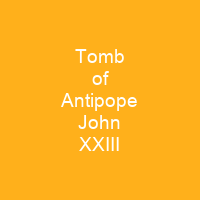The Tomb of Antipope John XXIII: A Masterpiece of Renaissance Art
Imagine a grand monument that stands as a testament to the complex history of the early Renaissance, blending artistry and politics in a way that few other works can. This is the Tomb of Antipope John XXIII, a marble-and-bronze masterpiece created by Donatello and Michelozzo for the Florence Baptistry adjacent to the Duomo. Commissioned after Cossa’s death in 1419, it was completed during the 1420s, establishing itself as one of the early landmarks of Renaissance Florence.
Who Was Antipope John XXIII?
Was he a simple man or a complex figure with a tumultuous life? Antipope John XXIII was indeed a Neapolitan nobleman who grew up in Bologna and had a life filled with intrigue. He encouraged rebellion against Pope Gregory XII, was deprived of his cardinalate, and succeeded Alexander V as John XXIII in 1410. However, he was eventually deposed by the Council of Constance in 1415 and died on December 22, 1419.
Why Was He Buried in the Florence Baptistry?
The commissioning of Cossa’s tomb monument was a long process that spanned about a decade following his death. His last will and testament left most of his estate to his nephews Michele and Giovanni, while leaving four prominent Florentines as executors: Bartolommeo di Taldo Valori, Niccolò da Uzzano, Giovanni di Bicci de’ Medici, and Vieri Guadagni. The executors claimed that Cossa had desired burial in the Baptistry, but it is unclear if he actually did.
Design and Construction
The design of the tomb monument incorporated elements from the Baptistry, including three existing sarcophagi. The tomb went over budget, costing an estimated 1,000 florins, although it is unclear who covered the excess. At 32 metres in height, it was the tallest monument in the Baptistry and at the time, the tallest in Florence.
The Monument’s Structure
The tomb features a white and brown marble base slab resting on a 38-centimetre high plinth, separated by a cornice and concave mouldings. The pylon is decorated with winged angel heads, garlands, and ribbons. Above the pylon are the three Virtues (Faith, Charity, and Hope) in shell niches.
The Virtues
Four Corinthian fluted pilasters, an unprecedented motif in Tuscan funerary sculpture at that time, frame the design. The central figure of Charity is the most antique, assimilating elements from Classical depictions of Abundantia, Ceres, and Juno. The Virtues were meant to distance the viewer from the effigy, emphasizing a generic pontiff instead of a specific individual.
The Effigy
On top of a sarcophagus with Cossa’s family arms and papal symbols, four classical consoles support the bier of an effigy. The effigy itself, made of gilded-bronze and life-size, shows Cossa dressed in a cardinal’s costume but without actual burial clothes. There is no precedent for a three-dimensional gilded-bronze effigy on an Italian tomb monument.
The Canopy
Behind the effigy is a tripartite pylon with sunk molded borders, an entablature of the Madonna and Child, and a gilt-edged architectonic canopy decorated with patterned stemmed flowers. The canopy is believed to be based on the ‘Dome of Heaven’ or a secular bed-canopy.
Collaboration Between Donatello and Michelozzo
The Tomb of Antipope John XXIII was Donatello’s first collaboration with Michelozzo, leading to future collaborations in Naples and Montepulciano. Attribution of the tomb to Donatello or Michelozzo varies among art historians due to historiographical interest rather than objective criteria.
Conclusion
The Tomb of Antipope John XXIII stands as a remarkable example of Renaissance art, blending political intrigue with artistic genius. It is not just a tomb but a narrative of the times, reflecting the complex interplay between politics and religion in early 15th-century Florence.

You want to know more about Tomb of Antipope John XXIII?
This page is based on the article Tomb of Antipope John XXIII published in Wikipedia (retrieved on November 29, 2024) and was automatically summarized using artificial intelligence.







